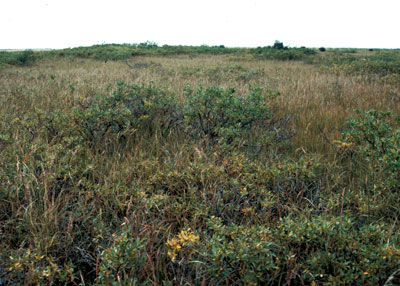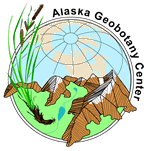Circumpolar Arctic Vegetation Unit W3
- CAVM
- Vegetation
- About the Vegetation Map Units
- Bioclimate Subzones
- Floristic Provinces
- AVHRR
- Elevation
- Lake Cover
- Physiography
- NDVI and Phytomass
- Substrate Chemistry
- Coastline
- Literature
Barrens:
B1B1. Cryptogam, herb barren -
B2B2. Cryptogam barren complex (bedrock) -
B3B3. Noncarbonate mountain complex -
B4B4. Carbonate mountain complex ||
Graminoid Tundras:
G1G1. Rush/grass, forb, cryptogam tundra -
G2G2. Graminoid, prostrate dwarf-shrub, forb tundra -
G3G3. Non-tussock sedge, dwarf-shrub, moss tundra -
G4G4. Tussock-sedge, dwarf-shrub, moss tundra ||
Prostrate-shrub Tundras:
P1P1. Prostrate dwarf-shrub, herb tundra -
P2P2. Prostrate/hemiprostrate dwarf-shrub tundra ||
Erect-shrub Tundras:
S1S1. Erect dwarf-shrub tundra -
S2S2. Low-shrub tundra ||
Wetlands:
W1W1. Sedge/grass, moss wetland -
W2W2. Sedge, moss, dwarf-shrub wetland -
W3W3. Sedge, moss, low-shrub wetland
Hierarchy of Geobotanical Vegetation Map Units (Walker DA 2002)

 W3. Sedge, moss, low-shrub wetland
W3. Sedge, moss, low-shrub wetland
Wetland complexes in the warmer areas of the Arctic, dominated by sedges and low shrubs >40 cm tall. Subzone E.
Detailed Description
Wetlands in Subzone E, often bog/fen complexes with deep organic soils. Large components of dwarf-shrub tundra (Unit S1) or tussock tundra (Unit G4) are usually present in slightly elevated microsites such as peat plateaus, and palsas.
Area: 159 x 1000 km2.
Representative Syntaxa
Plant communities of the classes Oxycocco-Sphagnetea Br. -Bl. et Tx. 1943 and Scheuchzerio-Caricetea (Nordh. 1936) Tx. 1937 (cf. Ledo decumbentis-Betuletalia glandulosae Rivas-Martinez et al. 1999).
Dominant Plants
Wet sites are dominated by sedges and mosses. The main plant communities on elevated microsites are shrublands with prostrate and erect dwarf-shrubs and mosses.
-
- Sedge: Eriophorum vaginatum; Carex chordorrhiza; Carex rotundata; Carex rariflora;
- Moss: Sphagnum; Calliergon stramineum;
- Prostrate and erect dwarf-shrubs: Ledum palustre spp. decumbens; Vaccinium; Empetrum; Rubus chamaemorus; Oxycoccus microphyllum; Salix richardsoniin; Salix fuscescens; Salix myrtilloides; Salix pulchra; Betula nana s.l.;
a=acidic, n=non-acidic


